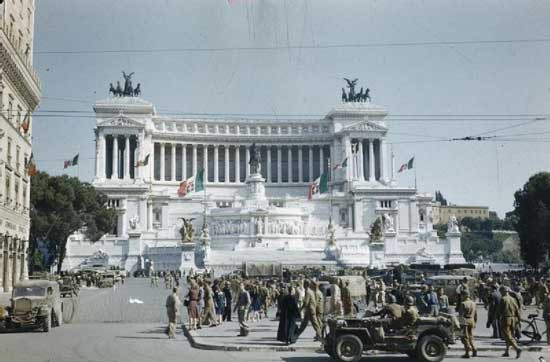In Rome, on Piazza Venezia, stands a monument, in all its grandeur, visible from many angles: the Vittoriano. During daytime or at night, at whatever time of the day you may find yourself passing by the Campidoglio (Capitoline), the Vittoriano, also known as the Altar of the Fatherland or to the Unknown Soldier, will surprise you in all its magnificence.

This famous National Monument was built to honour and house the remains of Italy’s first king, Vittorio Emanuele II. The construction project is the work of Giuseppe Sacconi, who had immagined this place as a veritable allegory of Italy, a celebrative symbol of the national territory and its spirit, unified within a single monument. All the sculptures housed in the Altar testify the root intentions of its construction. The groups of the Pensiero (Thought), of the Concordia (Concord), the Diritto (Law) are just a few of the symbolic representations that can still be admired today. Among the reliefs and sculptures, the only non-symbolic but realistic representation is the one of Vittorio Emanuele.
The Vittoriano is not only an important architectural landmark of the capital and of the nation’s history, but it is also an active cultural centre, home to art exhibitions and important initiatives. After all, this multifaceted nature has been part of the Altar of the Fatherland from its origins. In 1921, the Altar of the Fatherland housed the mortal remains of the Unknown Soldier, a fact that strengthened, allegorically speaking this monument, unique in its genre, but already in 1915 a famous event was celebrated in honour of all who had died during the war.
It has been said that only upon the death of the Nation’s Father, Vittorio Emanuele II, was it decided to celebrate his historical figure with a monument. It was 1878, and only a few years later, in 1880, a French architect, Nénot, won the competition for the construction of the monument dedicated to the King. This event, however, did not lead to any real building stage, which is why a second competition was announced a few years later, in 1882, which was now won by Giuseppe Sacconi, a native of the region of Marche. The proposal presented some general guidelines for the project: for example, the complex was to be built on Campidoglio, it was to displaying an equestrian statue dedicated to the King, a background of a specific extension, expressed in meters and it was to stand in such a way as to cover the buildings behind it.

Those who love the unforgettable views over the city of Rome will certainly not be disappointed once they reach the Terrace of the Quadrigae, on top of the Vittoriano complex. From here you can admire one of the most beautiful views of the capital. It is indeed a very strategic spot, which allows a very wide view of the city. From here you can see the Coliseum but also some of the old churches in the centre, the Roman Forum, the Tiber, the Quirinal and even the hills of the Roman Castles.
Many are the events which have taken place within this space, starting with the exhibitions of modern and contemporary art. Cézanne, Mondrian, Sironi, retrospectives of internationally renowned artists, photo exhibitions. The Vittoriano is a treasure chest that still today celebrates the creative freedom innate in every form of art, in any historical period.


